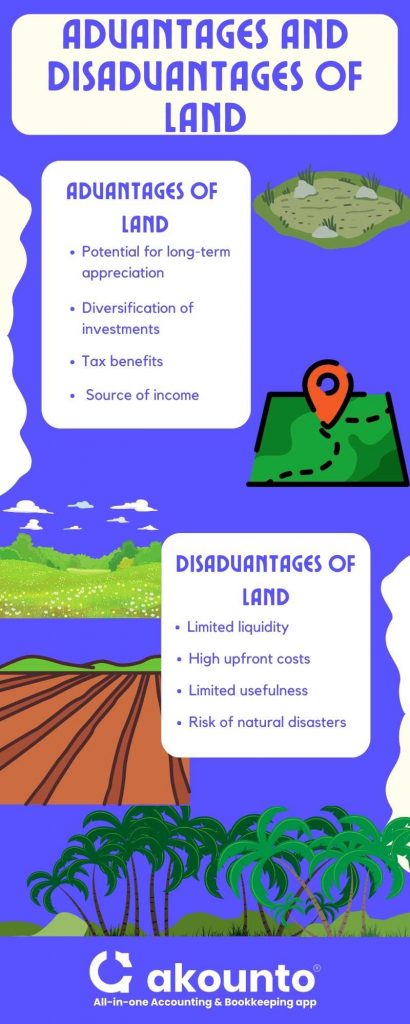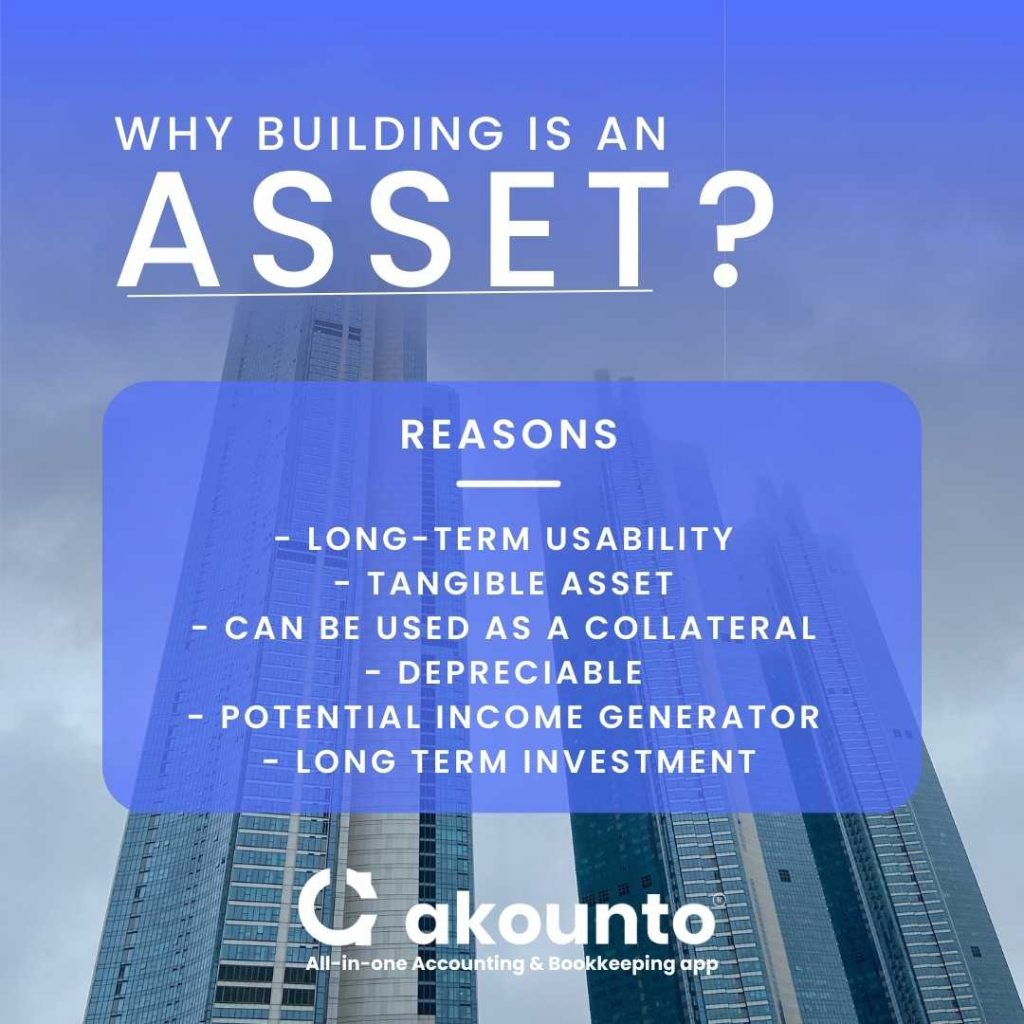Yes, the land is a fixed asset because it is a long-term, tangible asset that a company owns and expects to use for an extended time.
Fixed assets, also known as property, plant, and equipment (PP&E), are tangible assets with a useful life of more than one accounting year and are used in a company’s business operations.
Accounting records land as a fixed asset on a company’s balance sheet. It is typically not subject to depreciation because it is not expected to lose its value over time. However, improvements made to the land, such as buildings or infrastructure, may be subject to depreciation.
Examples of Land as an Asset
Land as a fixed asset (long-term asset) is one of the factors of production in an economic sense. For commercial purposes, land or real estate is one of the most preferred collaterals for secured loans.
Owning land also comes with the rights to natural resources (oil, gas, mineral ores, etc.) that can be explored within the physical boundaries of the land.
Commercial Real Estate
Land built or designated for business uses, such as office buildings, retail establishments, and industrial facilities, is commercial real estate.
Due to its ability to generate cash through rent or lease payments, it is a desirable asset for enterprises. It is often situated in high-demand locations, which may eventually cause its value to rise.
Agricultural Land
Another form of land that might be valuable is agricultural land. Land utilized for farming or other agricultural activities, such as raising cattle or cultivating crops, is referred to by this phrase. Selling goods grown or raised on agricultural lands, such as crops or cattle, can bring in money.
Advantages of Owning Land for Small Businesses
- Potential for long-term appreciation: Land can appreciate over time, generating profits for small businesses that hold onto the land for an extended period. As the land’s value increases, it can contribute to the company’s net worth.
- Diversification of investments: Investing in land can diversify a small business’s investments, which can help mitigate risks associated with other asset classes, like inventories or bonds.
- Diversification is essential for small businesses to create a balanced investment portfolio and manage risk effectively.
- Source of income: Land can also be used to generate income, either through the sale of natural resources, such as timber or minerals or through the use of the land for agricultural or commercial purposes. For example, small business owners can lease the land for farming or rent it for events.
- Tax benefits: Land ownership can provide tax benefits for small businesses, such as deductions for property taxes and mortgage interest payments, as well as depreciation deductions for the development of the land.
- These tax benefits can help small business owners in reducing their overall tax liability and improve their financial position.

Disadvantages of Owning Land for Small Businesses
- Limited liquidity: Land is an illiquid asset that cannot be easily converted into cash. This limited liquidity can disadvantage small businesses that need to pay bills or capital expenditures in the short term. Selling land can take time, and additional costs may be associated with the sale, such as real estate commissions and legal fees.
- High upfront costs: Land acquisition often involves high upfront costs, which may include the purchase price, registration fees, and other legal expenses related to the acquisition.
- Developing the land can require significant capital expenditures, such as the construction of buildings or infrastructure, which may take several years to pay off. These high upfront costs can impact small businesses’ profits, especially in the short term.
- Limited usefulness: Land has limited service since it can only be used for specific purposes. This limited usefulness can make it difficult for small businesses to profit from their investment in the short term.
- Zoning restrictions or land-use regulations may limit land use, further impacting its potential profitability.
- Risk of natural disasters: Land is also subject to natural disasters, like floods or wildfires, which can affect the land value and the ability of small businesses to realize a profit. Insurance coverage may help mitigate some of these risks, but premiums can be expensive, and not all natural disasters may be covered by insurance policies.
Asset Classification and Its Relation to Land
Understanding asset classification is essential for accurate financial reporting and efficient asset management. By organizing assets into specific categories, small businesses can better understand their asset portfolio and use this information to make strategic business decisions.
Land, as a fixed asset, is classified as a long-term, tangible asset. By grouping assets into categories such as current and non-current assets, tangible and intangible assets, and fixed and current assets, small businesses can determine the value and track changes in their asset portfolio over time.
The land is generally not disposed of or converted to cash within an accounting year; therefore, land cannot be classified as a current asset and thus is a long-term asset. Examples of current assets are cash in the bank, money, stock, etc.
The land is also a physical asset and therefore classified as a tangible asset. To understand, let us see some examples of intangible assets:
- Goodwill
- Trademarks
- Patents
- Licenses
- Investments
Knowing the classification of land as a fixed asset helps small businesses make informed decisions about land acquisition, development, and disposal. It also enables them to manage their assets more effectively and ensure compliance with accounting standards and regulations.
How is Land Recorded on a Balance Sheet?
Brief Description of Balance Sheet
A balance sheet provides an overview of a business’s financial position at a specific date in an accounting year. It is divided into two main sections: assets and liabilities.
The balance sheet’s asset section includes the following:
- Current assets like cash, inventory, marketable securities, short-term income, accrued income, petty cash, cash at the bank, deferred income, etc.
- Long-term assets Property, plant, and equipment (PP&E) – such as land, buildings, equipment, and vehicles; long-term investments; deferred charges, etc.
Current assets (liquid assets) are expected to be converted into cash within one year, while long-term assets usually have a useful life of more than one accounting year. Land cannot be classified as a current asset.
The balance sheet’s liabilities section includes current and long-term liabilities, such as accounts payable, loans, and mortgages and equity section. Current liabilities are expected to be due within one year, while long-term ones are due in more than one year. The equity section represents money owed to the owners and shareholders.
Land in Balance Sheet
The land is classified as a fixed asset under the long-term asset category, which has a useful life that extends beyond one accounting period and can be used to generate revenue through various means, such as leasing or development.
The balance sheet records the land at its historical cost, including the price at which the land is purchased and any other auxiliary costs related to the acquisition process. Neither land is depreciated, nor the fair market value nor changes in inflation are not adjusted to the land value.
Interpretation of land in the Balance sheet
Land is a key component of a company’s asset portfolio, and its classification on a balance sheet is important to investors. The land is a long-term asset that indicates a company’s strategic investments for future growth. Its appreciation over time can also contribute to a company’s overall net worth.
Investors prefer to see more long-term and fixed assets on a company’s balance sheet, including land. Fixed assets represent a more stable asset base and indicate a company’s long-term value.
The land value may also be of interest to investors as it can appreciate over time and generate profits for the company.
Is a Building an Asset?
Yes, a building is classified under fixed assets in accounting terms. A building is a long-term tangible asset that is used in the operations of a company or owned for long-term investment purposes.

Here are some reasons why a building is considered a part of fixed assets:
- Long-term use: A building is a long-term asset expected to be used in company operations or owned for long-term investment purposes for more than one year.
- Tangible nature: A building is a physical asset that can be seen, touched, and used to generate revenue.
- Balance sheet treatment: A building is recorded on the balance sheet as a long-term asset under fixed assets at its historical cost, which comprises the cost price, closing price, and any additional expenses related to acquiring the building.
- Depreciation: Unlike land, the building is subjected to depreciation as per IRS rules. Like other long-term assets, depreciated value is adjusted in the balance sheet, while depreciation expenses are shown as loss in the income statement.
- Potential revenue generation: A building can generate revenue through rent or lease payments.
Conclusion
Of all the fixed assets, land is a significant asset for businesses. Recording it on the balance sheet is crucial as it helps to determine the company’s net worth and financial position. Land has a huge upfront cost but also serves as collateral for future funding.
Purchasing land can be a capital investment for a business and signals the long-term intention of the small business when it comes to the “going concern” principle. Purchasing land initially for a startup or a small business may not be feasible, but for a large business, it is beneficial.




